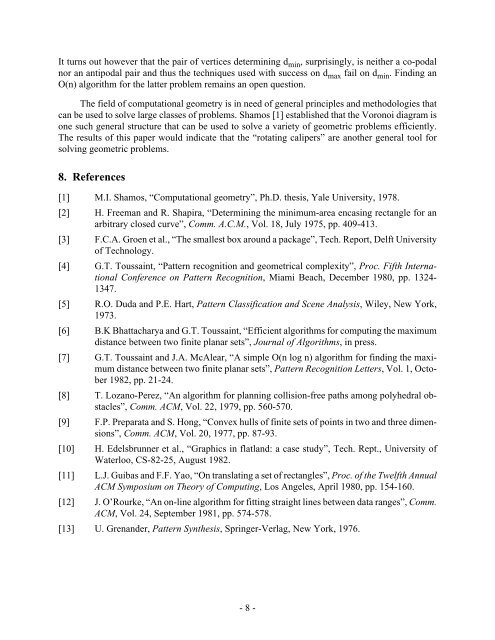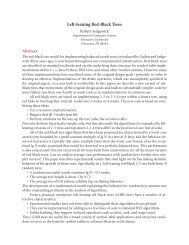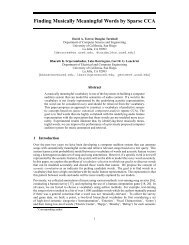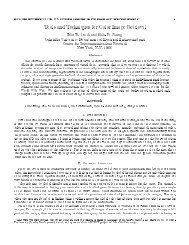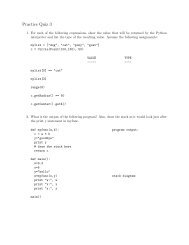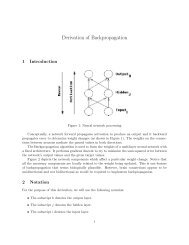Solving Geometric Problems with the Rotating Calipers *
Solving Geometric Problems with the Rotating Calipers *
Solving Geometric Problems with the Rotating Calipers *
Create successful ePaper yourself
Turn your PDF publications into a flip-book with our unique Google optimized e-Paper software.
It turns out however that <strong>the</strong> pair of vertices determining d min , surprisingly, is nei<strong>the</strong>r a co-podal<br />
nor an antipodal pair and thus <strong>the</strong> techniques used <strong>with</strong> success on d max fail on d min . Finding an<br />
O(n) algorithm for <strong>the</strong> latter problem remains an open question.<br />
The field of computational geometry is in need of general principles and methodologies that<br />
can be used to solve large classes of problems. Shamos [1] established that <strong>the</strong> Voronoi diagram is<br />
one such general structure that can be used to solve a variety of geometric problems efficiently.<br />
The results of this paper would indicate that <strong>the</strong> “rotating calipers” are ano<strong>the</strong>r general tool for<br />
solving geometric problems.<br />
8. References<br />
[1] M.I. Shamos, “Computational geometry”, Ph.D. <strong>the</strong>sis, Yale University, 1978.<br />
[2] H. Freeman and R. Shapira, “Determining <strong>the</strong> minimum-area encasing rectangle for an<br />
arbitrary closed curve”, Comm. A.C.M., Vol. 18, July 1975, pp. 409-413.<br />
[3] F.C.A. Groen et al., “The smallest box around a package”, Tech. Report, Delft University<br />
of Technology.<br />
[4] G.T. Toussaint, “Pattern recognition and geometrical complexity”, Proc. Fifth International<br />
Conference on Pattern Recognition, Miami Beach, December 1980, pp. 1324-<br />
1347.<br />
[5] R.O. Duda and P.E. Hart, Pattern Classification and Scene Analysis, Wiley, New York,<br />
1973.<br />
[6] B.K Bhattacharya and G.T. Toussaint, “Efficient algorithms for computing <strong>the</strong> maximum<br />
distance between two finite planar sets”, Journal of Algorithms, in press.<br />
[7] G.T. Toussaint and J.A. McAlear, “A simple O(n log n) algorithm for finding <strong>the</strong> maximum<br />
distance between two finite planar sets”, Pattern Recognition Letters, Vol. 1, October<br />
1982, pp. 21-24.<br />
[8] T. Lozano-Perez, “An algorithm for planning collision-free paths among polyhedral obstacles”,<br />
Comm. ACM, Vol. 22, 1979, pp. 560-570.<br />
[9] F.P. Preparata and S. Hong, “Convex hulls of finite sets of points in two and three dimensions”,<br />
Comm. ACM, Vol. 20, 1977, pp. 87-93.<br />
[10] H. Edelsbrunner et al., “Graphics in flatland: a case study”, Tech. Rept., University of<br />
Waterloo, CS-82-25, August 1982.<br />
[11] L.J. Guibas and F.F. Yao, “On translating a set of rectangles”, Proc. of <strong>the</strong> Twelfth Annual<br />
ACM Symposium on Theory of Computing, Los Angeles, April 1980, pp. 154-160.<br />
[12] J. O’Rourke, “An on-line algorithm for fitting straight lines between data ranges”, Comm.<br />
ACM, Vol. 24, September 1981, pp. 574-578.<br />
[13] U. Grenander, Pattern Syn<strong>the</strong>sis, Springer-Verlag, New York, 1976.<br />
- 8 -


